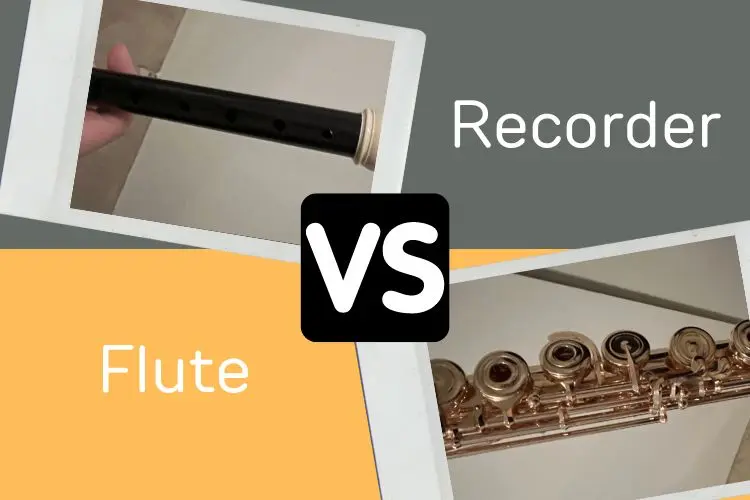Do you want to expand your musical skills with a different type of woodwind? Compare the flute vs. recorder to learn how they stack up.
Here’s what you need to know about these two types of flutes.
But, first, let’s look into their context and history.
History of the Recorder
Vertical flutes, such as the recorder, have been around for thousands of years. However, the recorder we know today didn’t get its start until the Middle Ages.
Recorders were used as solo instruments and in ensembles throughout the Baroque era. As the flute rose to prominence, the recorder’s popularity faded.
In the 20th century, the Dutch musician Frans Bruggen brought the recorder back. Now, many players focus on the instrument even though it’s still not a part of the modern orchestra.
History of the Flute
Transverse flutes have also had a long history. In the Baroque era, players would perform on a traverso, which is the main predecessor to the modern flute.
However, as the orchestra grew and changed, the traverso couldn’t keep up. In the 1840s, German flute maker Theobald Boehm started experimenting with a metal instrument with larger tone holes and keys.
While flute players didn’t start playing it right away, Boehm’s design has become the main choice of western concert flute players today.
What Are the Main Differences Between the Recorder and Flute?
The flute and recorder have some differences that you should know before playing one or the other. While you can play both, each instrument requires a unique technique.
Here are some significant differences between the flute and the recorder.
| Recorder | Flute |
|---|---|
| Held vertically, can be played right or left-handed | Held horizontally, rarely played left-handed, even by left-handed musicians |
| Has 10 tone holes | Has 16 or 17 tone holes, some of which are controlled by keys |
| Uses many forked fingerings, especially for chromatic notes | Only uses forked fingerings in the third octave, uses keys for chromatic notes |
| Uses two sets of fingerings for recorders in C and recorders in F | Uses the same set of written fingerings, music is transposed when necessary |
| Standard range is only about two octaves | Standard range is about three octaves, larger for some advanced players |
| Form your lips around the mouthpiece | Form your lips like blowing over a bottle |
| Student models are of plastic, professional models are of wood | Student models are silver-plated, professional models are solid silver but may also use gold, platinum, or grenadilla wood |
| Mainly plays Baroque and Modern music, rarely appears in orchestral music | Has repertoire from the Baroque era to now, a standard member of the orchestra |
| Most instruments are $1,000 or less | Most instruments start at $500 and can quickly reach the thousands |
Read on for more details about each difference.
Playing Position
One of the most obvious differences is how you hold the instruments to play. When you play the concert flute, you’ll hold the instrument off to your right. The lip plate will go against your lip, and that’s where you blow.
Regardless of whether you’re right or left-handed, you’ll play your flute to the right. If you play the recorder, you can find left-handed instruments to play more comfortably.
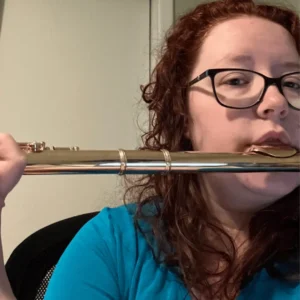
Also, recorder players hold the instrument vertically. The mouthpiece is at the top, and that’s where you’ll blow into the instrument.
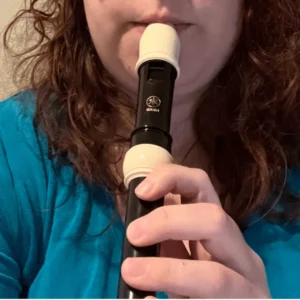
Holes and Keys
Another major difference is that the flute has keys to cover the holes. That allows you to play chromatically more easily. While your fingers close some of the holes directly, others will trigger certain holes to open or close.
If you play the recorder, you will use your fingers to close the holes. Because of that, you have to have the perfect hand position. Of course, some flutes have open holes, but they still have the key system to help close other holes.
On the other hand, some massive recorders have keys. The holes on those recorders are either too large or too far away from each other to play without keys.
The Fingering System
The fingering systems for the flute and recorder are similar. In general, the more holes you close, the lower the note, and the more you open, the higher the note. However, the recorder uses more forked fingerings than the flute.
A forked fingering is when you close some number of holes. You leave the next few holes open before closing another hole or two.
Also, all flutes will use the same written fingerings, despite transpositions. For example, the alto flute sounds in G, so the notes simply sound a fourth lower.
However, recorders use different fingerings depending on the type of recorder. The lowest note on the soprano and tenor recorders is a C, so the fingering system is similar to the flute. If you play a sopranino, alto, or bass recorder, the lowest note will be an F.
While on a soprano recorder, that would use your left thumb, first, second, third, and right-hand first finger, you’d use all of your fingers on an alto recorder.
The Range
Another difference between the flute and the recorder is their range. For one, the most common flute (the C flute) sounds exactly as written. However, the most common recorder (the soprano) sounds an octave higher than written.
The concert flute has a range of about three octaves, from middle C or the B just below to the C or D an octave and a half above the staff. Some players can go higher with plenty of practice.
On the other hand, the recorder’s range is just over two octaves. Using the soprano recorder as an example, the written range is from middle C to the D just above the staff, though everything sounds an octave above. The alto recorder range is from the F in the treble clef to the G an octave above the staff.
The Embouchure
Both the flute and recorder require a specific embouchure, which is how you form your lips. Playing the flute is almost like blowing over the top of a bottle. You have to form your lips as if you’re about to kiss someone, and you blow the air out over the embouchure hole.
On a recorder, you blow directly into the instrument. You’ll place your lips around the top of the mouthpiece, and then you can blow to produce a sound. Inside the recorder is a block and a windway, and the air splits there to make the notes come out.
Instrument Materials
Most concert flutes you’ll flute are made of metal. Nickel silver with a layer of silver plating is common at the beginner level, while more advanced flutes use solid silver. Some flutes even use gold or platinum.
A few companies make wood flutes, but they still use the same modern fingering system. The wood flutes out there tend to use grenadilla.
However, many student-level recorders are made of plastic. Some have the color of wood, while others use wild colors, such as blue or pink.
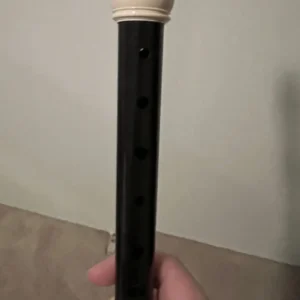
Repertoire
You should also consider the type of music you can play on the flute vs. recorder. The flute is common in many orchestras and wind ensembles. It’s also a standard part of the woodwind quintet, and there are many solos and other chamber pieces for it.
The flute has a repertoire from the Baroque, Classical, Romantic, and Modern eras. It has much more music than the recorder.
You can find some recorder music from the Baroque era. Some experts believe the famous Vivaldi concertos for piccolo were originally written for the sopranino recorder.
Most of the recorder family’s music comes from the Baroque era, from about 1600 to 1750. However, the recorder does have some modern solos and ensemble pieces.
Pricing
If you’re trying to decide between the flute and recorder, consider the recorders are usually much more affordable. You can find decent recorders for less than $20. On the other end of the spectrum, professional recorders may cost over $1,000.
A good flute will cost about $500 or more when new. You can find used instruments for less, and you can find some new flutes for around $100. Unfortunately, those cheap flutes aren’t usually going to last very long.
One of the most expensive flutes currently for sale costs about $97,000. Luckily, most flutes don’t cost nearly that much. If you need a professional flute, you can spend around $5,000 to $25,000.
Flute and Recorder Similarities
The flute and recorder have multiple differences. However, they also have some similarities that you should consider.
First, they’re both woodwinds, and more specifically, they’re both technically flutes. The concert flute is a side-blown, transverse flute. That means you blow into the side of the instrument, and you do this through the embouchure hole.
Another name for the recorder is the “sweet flute,” and it’s an end-blown, fipple flute. The fipple sits inside the mouthpiece and is what helps produce the sound. You blow into the end of the instrument rather than on the side of it.
While some of the fingerings are different, others are the same. For example, the concert flute and the soprano recorder share fingerings for the notes C, D, E, G, A, and B in the first octave.
Both Instruments Are Part of Larger Instrument Families
The concert flute family includes
(from top to bottom)
- Piccolo
- G treble flute
- Eb flute
- C flute (the main flute)
- Flute D’Amore (in Bb or A)
- Alto flute in G
- Bass flute in C
- Contra’alto flute in G
- Contrabass flute in C
- Double contrabass flute in C
- Hyperbass flute in C
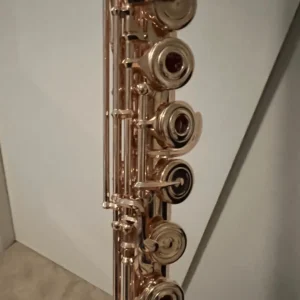
The recorder family includes
(From small to large)
- Garklein
- Sopranino
- Soprano (or descant)
- Alto
- Tenor
- Bass
- Great bass
- Contrabass
- Sub-great bass
- Sub-contrabass
Here’s a video about the world’s largest recorder.
Recorder vs. Flute: How They Compare
Whether you’re new to music or currently play the flute or recorder, you should know how the two instruments compare.
By doing this comparison about their differences, but also their similarities, I hope that it’s now easier for you to decide which one might be better for you to learn and play (or even motivate you to learn and play both)
Commons Asked Questions When Comparing Recorders and Flutes
Which Is Better: Flute or Recorder?
The better instrument between the flute and recorder depends on the player. As a flutist, I prefer the flute since it’s more common in orchestras and has more solo repertoire.
However, the recorder is better for players on a budget since most good instruments are affordable. The recorder is also easier to learn, and the embouchure is more forgiving due to the fipple design.
Is the Recorder Easier Than the Flute?
The recorder is generally easier than the flute. It has fewer tone holes, none of which use keys over them.
Also, the recorder uses a more natural playing position since it’s in front of the player. The flute’s sideways position can be hard to get used to.
Is Playing Flute Similar to a Recorder?
Playing the flute is similar to playing the recorder. For one, both require good air control to help get a nice sound.
Also, the fingerings are very similar, though there are some major differences. At a basic level, if you can play one, you can usually learn the other more easily.
Is the Flute Louder Than the Recorder?
The flute can play louder than the recorder. While you can play the recorder loudly, you can only push the air so much before the sound starts to crack.
A flute can play louder while maintaining a clear, brilliant tone.
What Instrument Should I Learn After the Recorder?
You should learn an instrument that you want to learn. The flute and the clarinet are both popular choices since they’re all part of the woodwind family.
A flute will be easier to learn since you don’t have a reed. However, the clarinet has a more similar playing position, and some of the fingerings are the same as those of a recorder.
